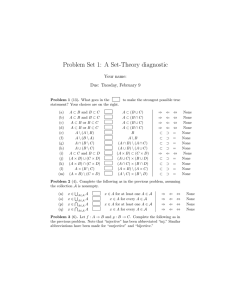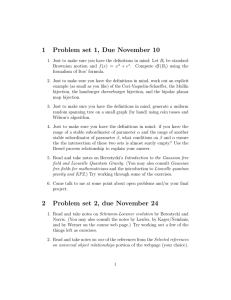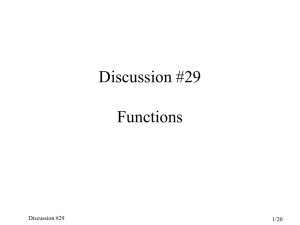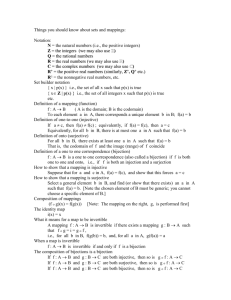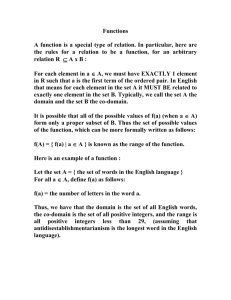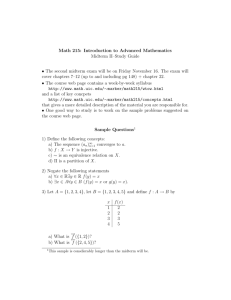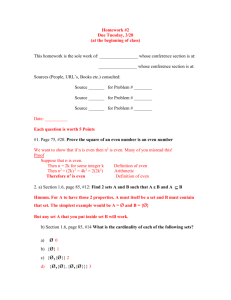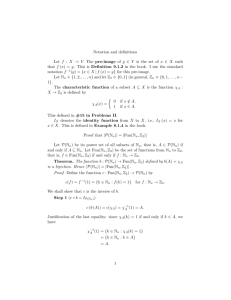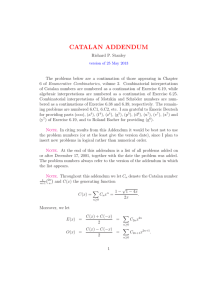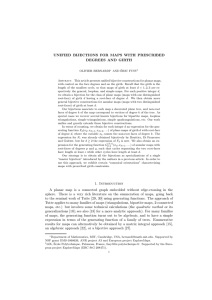Problem Set 1: A Set-Theory diagnostic
advertisement
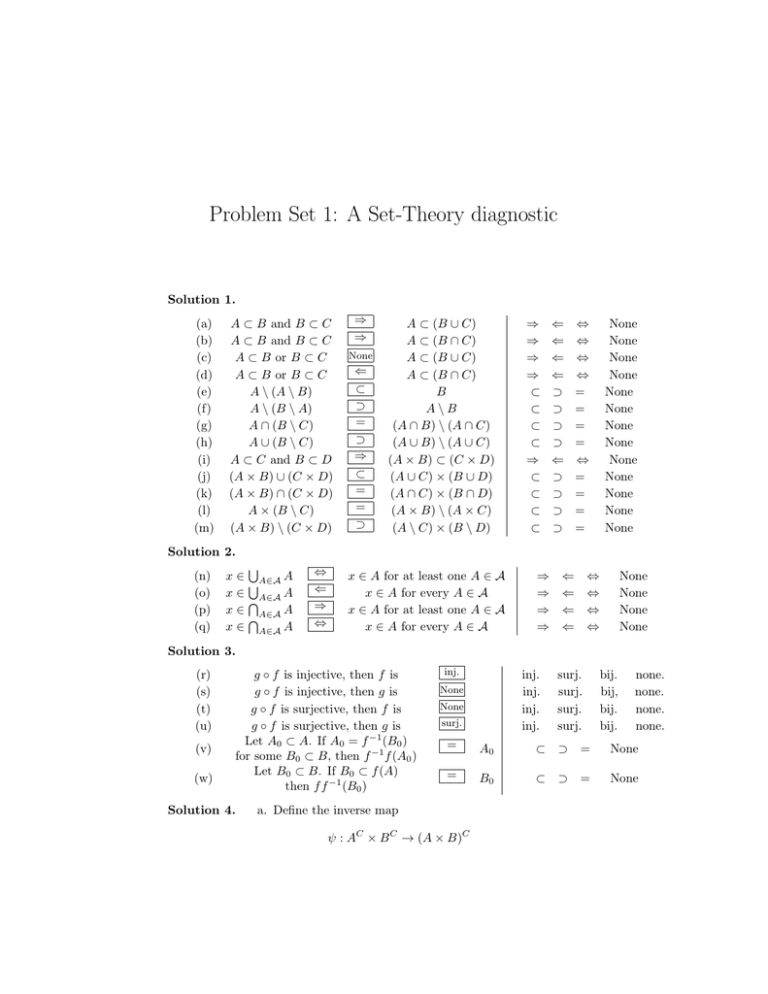
Problem Set 1: A Set-Theory diagnostic
Solution 1.
(a)
(b)
(c)
(d)
(e)
(f)
(g)
(h)
(i)
(j)
(k)
(l)
(m)
A ⇢ B and B ⇢ C
A ⇢ B and B ⇢ C
A ⇢ B or B ⇢ C
A ⇢ B or B ⇢ C
A \ (A \ B)
A \ (B \ A)
A \ (B \ C)
A [ (B \ C)
A ⇢ C and B ⇢ D
(A ⇥ B) [ (C ⇥ D)
(A ⇥ B) \ (C ⇥ D)
A ⇥ (B \ C)
(A ⇥ B) \ (C ⇥ D)
)
)
None
(
⇢
=
)
⇢
=
=
A ⇢ (B [ C)
A ⇢ (B \ C)
A ⇢ (B [ C)
A ⇢ (B \ C)
B
A\B
(A \ B) \ (A \ C)
(A [ B) \ (A [ C)
(A ⇥ B) ⇢ (C ⇥ D)
(A [ C) ⇥ (B [ D)
(A \ C) ⇥ (B \ D)
(A ⇥ B) \ (A ⇥ C)
(A \ C) ⇥ (B \ D)
)
)
)
)
⇢
⇢
⇢
⇢
)
⇢
⇢
⇢
⇢
(
(
(
(
,
,
,
,
=
=
=
=
( ,
=
=
=
=
None
None
None
None
None
None
None
None
None
None
None
None
None
Solution 2.
(n)
(o)
(p)
(q)
S
x 2 A2A A
S
x 2 A2A A
T
x 2 A2A A
T
x 2 A2A A
,
(
)
,
x 2 A for at least one A 2 A
x 2 A for every A 2 A
x 2 A for at least one A 2 A
x 2 A for every A 2 A
)
)
)
)
(
(
(
(
,
,
,
,
None
None
None
None
Solution 3.
(r)
(s)
(t)
(u)
(v)
(w)
g f is injective, then f is
g f is injective, then g is
g f is surjective, then f is
g f is surjective, then g is
Let A0 ⇢ A. If A0 = f 1 (B0 )
for some B0 ⇢ B, then f 1 f (A0 )
Let B0 ⇢ B. If B0 ⇢ f (A)
then f f 1 (B0 )
Solution 4.
inj.
inj.
inj.
inj.
inj.
None
None
surj.
surj.
surj.
surj.
surj.
bij.
bij,
bij.
bij.
none.
none.
none.
none.
=
A0
⇢
=
None
=
B0
⇢
=
None
a. Define the inverse map
: AC ⇥ B C ! (A ⇥ B)C
by sending (g, h) to the unique function that maps c 2 C to (g(c), h(c) 2
A ⇥ B. Let
denote the given map (A ⇥ B)C ! AC ⇥ B C . Given
C
f 2 (A ⇥ B) , ( (f )) = (p1 f, p2 f ) sends c to (p1 f (c), p2 f (c)) =
f (c), for all c 2 C, hence it is equal to f . On the other hand given
(g, h) 2 AC ⇥ B C , ( (g, h)) = (p1
(g, h), p2
(g, h)). But (g, h)
sends c 2 C to (g(c), h(c); hence, p1
(g, h) = g and p2
(g, h) = h.
Thus ( (g, h)) = (g, h). Thus, and are inverse to each other and
is bijective.
b. Denote the given map by ✓. We will define its inverse
⌘ : CA ⇥ CB ! CA
`
B
by (g, h) 7! {(x, 0) 7! g(x), for x 2 A and (y, 1) 7! `
h(y), for y 2 B}. Then,
to show they are inverse to each other take f 2 C A B . Clearly, ⌘(✓(f )) =
⌘(f i1 , f i2 ) sends (x, 0) 2 A ⇥ {0} to f i1 (x) = f (x, 0) and (y, 1) 2
B ⇥ {1} to f (y, 1), thus it is equal to f. On the other hand, given
(g, h) 2 C A ⇥C B , ✓(⌘(g, h)) = (⌘(g, h) i1 , ⌘(g, h) i2 ). But ⌘(g, h) i1 (x) =
⌘(g, h)(x, 0) = g(x) for x 2 A, by definition. Similarly for y 2 B,
⌘(g, h) i2 (y) = h(y). Thus ✓(⌘(g, h)) = (g, h) and ✓ and ⌘ are inverse to
each other.
S
S
S
Solution
a. By definition
S 5.
Sh(C) = h( n2NSCn ) = n2N h(Cn ) = n2N Cn+1 =
n2N 1 Cn . Hence, C =
n2N Cn = C0 [
n2N 1 Cn = C0 [ h(C).
b. A \ C ⇢ A \ C0 = Im(g). So given x 2 A \ C there exist a unique y 2 B
such that x = g(y). If y 2 f (C), then x 2 g(f (C)) = h(C) ⇢ C by part a.
But this cannot happen by assumption, so y 2 B \ f (C). Thus A \ C ⇢
g(B \ f (C)). Conversely, given y 2 B \ f (C), if g(y) 2 C = C0 [ h(C),
then it is in h(C) as C0 \ Im(g) = ;. Thus the iclusion holds the other
way as well, and we have A \ C = g(B \ f (C)).
c. A\C ⇢ Im(g) and g is injective thus g 1 defines a bijection onto its image,
which is B \ f (C) by the above part. On the other hand, injectivity of
implies, its restriction to C defines a bijection onto f (C). This implies the
map k : A ! B defined by
(
f (x)
x2C
1
g (x) x 2 A \ C
is a bijection.
d. The function tan defines a bijection from ( ⇡/2, ⇡/2) to R. On the other
hand, there is a unique linear function sending a to ⇡/2 and b to ⇡/2
which is a bijection. The composition of these two functions give a bijection from (a, b) to R.
e. To use part c, we need to find injections both ways. The inclusion gives an
injection from U to R. On the other hand, the composition of a bijection
from R to the interval contained in U , which exists by part d, with the
inclusion map from the interval, gives as an injection from R to U . Hence
by part c, there is a bijection between U and R.
